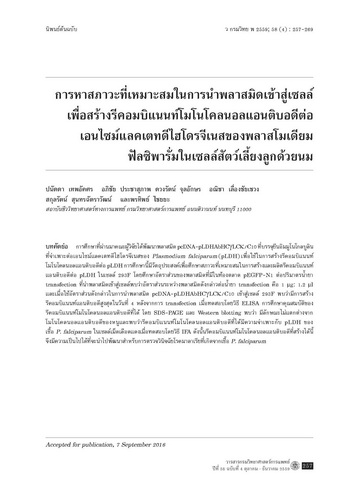การหาสภาวะที่เหมาะสมในการนำพลาสมิดเข้าสู่เซลล์ เพื่อสร้างรีคอมบิแนนท์โมโนโคลนอลแอนติบอดีต่อเอนไซม์แลคเตทดีไฮโดรจีเนสของพลาสโมเดียมฟัลซิพารั่ม ในเซลล์สัตว์เลี้ยงลูกด้วยนม
คำสำคัญ:
Recombinant Plasmodium falciparun monoclonal antibody, 293F cells, transfection, Plasmodium falciparum lactate dehydrogenaseบทคัดย่อ
การศึกษาที่ผ่านมาคณะผู้วิจัยได้พัฒนาพลาสมิด pcDNA-pLDHAbHCγLCκ/C10 ที่บรรจุยีนอิมมูโนโกลบูลินที่จำเพาะต่อเอนไซม์แลคเตทดีไฮโดรจีเนสของ Plasmodium falciparum (pLDH) เพื่อใช้ในการสร้างรีคอมบิแนนท์โมโนโคลนอลแอนติบอดีต่อ pLDH การศึกษานี้มีวัตถุประสงค์เพื่อศึกษาสภาวะที่เหมาะสมในการสร้างและผลิตรีคอมบิแนนท์แอนติบอดีต่อ pLDH ในเซลล์ 293F โดยศึกษาอัตราส่วนของพลาสมิดที่มีในท้องตลาด pEGFP-N1 ต่อปริมาตรน้ำยา transfection ที่นำพลาสมิดเข้าสู่เซลล์พบว่าอัตราส่วนระหว่างพลาสมิดดังกล่าวต่อน้ำยา transfection คือ 1 μg: 1.2 μl และเมื่อใช้อัตราส่วนดังกล่าวในการนำพลาสมิด pcDNA-pLDHAbHCγLCκ/C10 เข้าสู่เซลล์ 293F พบว่ามีการสร้างรีคอมบิแนนท์แอนติบอดีสูงสุดในวันที่ 4 หลังจากการ transfection เมื่อทดสอบโดยวิธี ELISA การศึกษาคุณสมบัติของรีคอมบิแนนท์โมโนโคลนอลแอนติบอดีที่ได้ โดย SDS-PAGE และ Western blotting พบว่า มีลักษณะไม่แตกต่างจากโมโนโคลนอลแอนติบอดีของหนูและพบว่ารีคอมบิแนนท์โมโนโคลนอลแอนติบอดีที่ได้มีความจำเพาะกับ pLDH ของเชื้อ P. falciparum ในเซลล์เม็ดเลือดแดงเมื่อทดสอบโดยวิธี IFA ดังนั้นรีคอมบิแนนท์โมโนโคลนอลแอนติบอดีที่สร้างได้นี้ จึงมีความเป็นไปได้ที่จะนำไปพัฒนาสำหรับการตรวจวินิจฉัยโรคมาลาเรียที่เกิดจากเชื้อ P. falciparum
เอกสารอ้างอิง
Saleem M, Kamal M. Monoclonal antibodies in clinical diagnosis: A brief review application. Afr J Biotechnol 2008; 7(8): 923-5.
Drewe E, Powell RJ. Clinically useful monoclonal antibodies in treatment. J Clin Pathol 2002; 55(2): 81-85.
Köhler G, Milstein C. Continuous cultures of fused cells secreting antibody of predefined specificity. Nature 1975; 256: 495-7.
Pandey S. Hybridoma technology for production of monoclonal antibodies. Int J Pharm Sci Rev Res 2010; 1(2): 88-94.
Hybridoma technology. [online].2015; [cited 2015 Jul 7]; [1 screen]. Available from: URL: https://en.wikipedia.org/wiki/Hybridoma_technology#Method.
Marx U, Embleton MJ, Fischer R, Gruber FP, Hansson U, Heuer J, et al. Monoclonal antibody production: The report and recommendations of ECVAM Workshop 23. ATLA 1997; 25(2): 121-37.
National Research Council (US) Committee on Methods of Producing Monoclonal Antibodies. Monoclonal antibody production [online]. 1999; [cited 2015 Jun 22]. Available from: URL: https://www.ncbi.nlm.nih.gov/books/NBK100192.
Castillo FJ, Mullen LJ, Grant BC, Deleon J, Thrift JC, Chang LW, et al. Hydridoma stability. Dev Biol Stand 1994; 83: 55-64.
Skerra A, Plückthun A. Assembly a functional immunoglobulin Fv fragment in Escherichia coli. Science 1988; 240(4855): 1038-41.
Ho M, Nagata S, Pastan I. Isolation of anti-CD22 Fv with high affinity by Fv display on human cells. PNAS 2006; 103(25): 9637-42.
Galeffi P, Lombardi A, Pietraforte I, Novelli F, Donato MD, Sperandei M, et al. Functional expression of a single-chain antibody to Erb-2 in plants and cell-free systems. J Transl Med 2006; 4: 39.
Choo ABH, Dunn RD, Broady KW, Raison RL. Soluble expression of a functional recombinant cytolytic immunotoxin in insect cells. Protein Expr Purif 2002; 24(3): 338-47.
Zhang RY, Shen WD. Monoclonal antibody expression in mammalian cells. Methods Mol Biol 2012; 907: 341-58.
Durocher Y, Perret S, Kamen A. High-level and high-throughput recombinant protein production by transient transfection of suspension-growing human 293-EBNA1 cells. Nucleic Acids Res 2002; 30: E9.
Thomas P, Smart TG. HEK293 cell line: a vehicle for the expression of recombinant proteins. J Pharmacol Toxicol Methods 2005; 51: 187-200.
CLONTECH Laboatories, Inc. PEGFP-N1 vector information. [online]. 1999; [cited 2015 Jul 27]; [3 screens]. Available from: URL: https://shigen.nig.ac.jp/medaka/download/strain/pEGFP-N1.pdf.
Inouye S, Tsuji FI. Aequorea green fluorescence protein. Expression of the gene and fluorescence characteristics of the recombinant protein. FEBS Lett 1994; 341: 277-80.
Prasher DC, Eckenrode VK, Ward WW, Prendergast FG, Cormier MJ. Primary structure of the Aequorea victoria green-fluorescent protein. Gene 1992; 111: 229-33.
Strober W. Trypan blue exclusion test of cell viability. Curr Protoc Immunol 2001; Appendix 3: Appendix 3B.
Markler MT, Hinrichs DJ. Measurement of the lactate dehydrogenase activity of Plasmodium falciparum as an assessment of parasitemia. Am J Trop Med Hyg 1993; 48(2); 205-10.
Chalfie M, Tu Y, Euskirchen G, Ward WW, Prasher DC. Green fluorescence protein as a marker for gene expression. Science 1994; 263: 802-5.
Khodthong C, Ismaili I, Juckem L. The Impact of transfection mediated toxicity-gene expression and cytotoxicity analysis of transfection reagents. [online]. 2012; [2015 Jun 20]; [10 screens]. Available from: URL: https://www.mirusbio.com/assets/misc_technical_documents/the_impact_of_transfection_mediated_toxicity.pdf.
Backliwal G, Hildinger M, Chenuet S, Wulhfard S, De Jesus M, Wurm FM. Rational vector design and multi-pathway modulation of HEK 293E cells yield recombinant antibody titers exceeding 1 g/l by transient transfection under serum-free conditions. Nucleic Acids Res 2008; 36(15): e96.
Kim TK, Eberwine JH. Mammalian cell transfection: the present and the future. Anal Bioanal Chem 2010; 397(8): 3173-8.
Schroeder HW, Cavacini L. Structure and function of immunoglobulins. J Allergy Clin Immunol 2010; 125(202): S41-52.

ดาวน์โหลด
เผยแพร่แล้ว
รูปแบบการอ้างอิง
ฉบับ
ประเภทบทความ
สัญญาอนุญาต

อนุญาตภายใต้เงื่อนไข Creative Commons Attribution-NonCommercial-NoDerivatives 4.0 International License.



